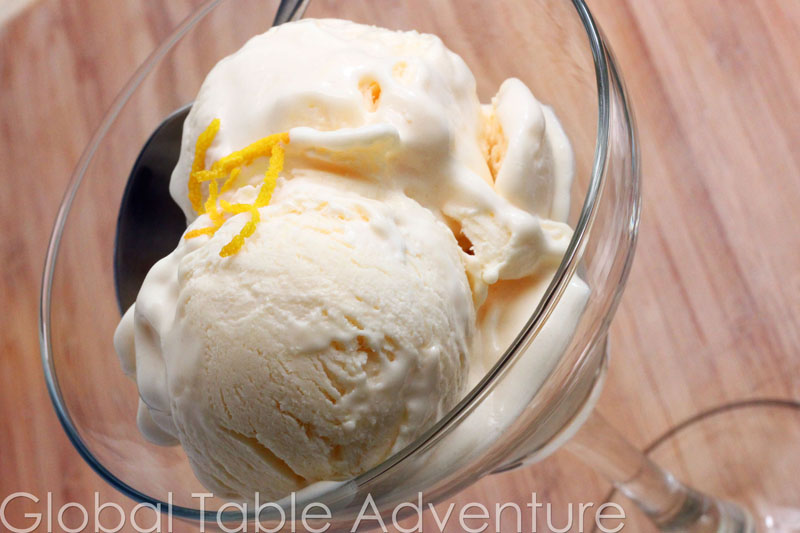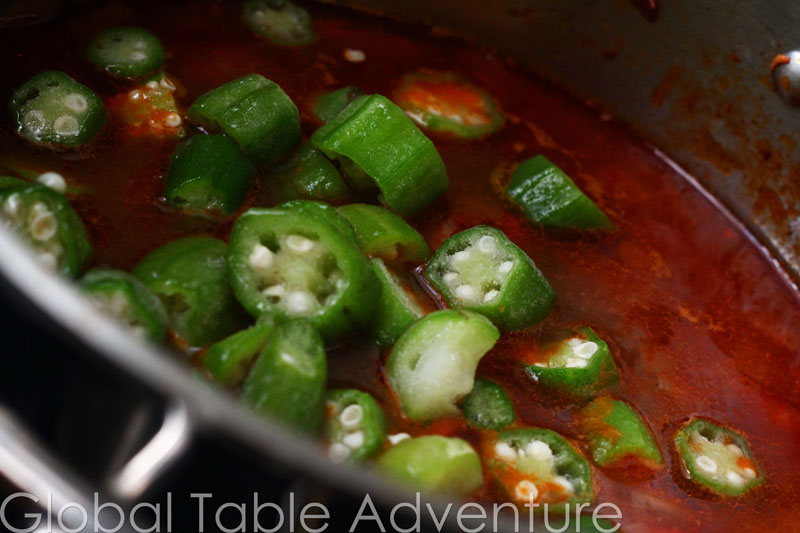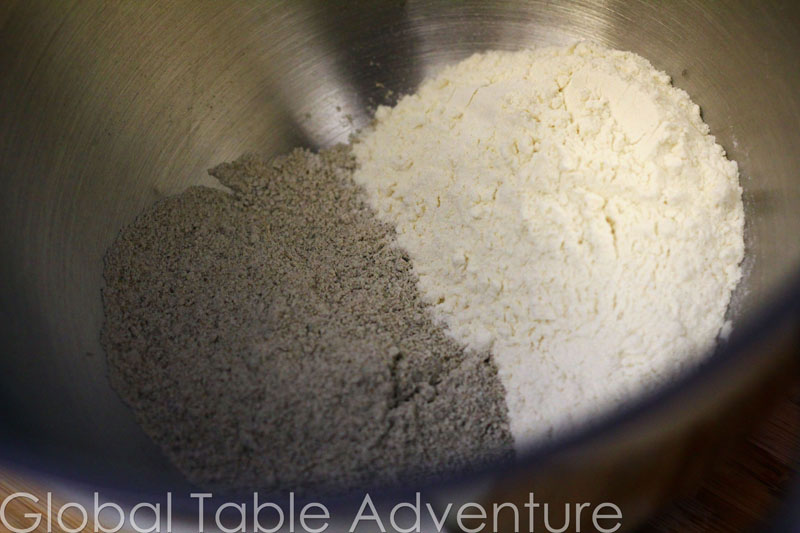I once bought an industrial ice cream maker at a church sale for $2.00. It had a built in freezer. It made a quart of ice cream at a time. It was dingy, off white, and from the eighties. It made the best “cookies and cream” ice cream ever. At the time, I had no idea what the value of a built in freezer on an ice cream maker is. (For those that don’t know, they normally cost a couple hundred dollars) Well. In my blissful state of ignorance, I decided the ice cream maker was too heavy to keep lugging around with me, so it took a trip to the thrift store, instead of to Tulsa, with me. Oh. If I could take that decision back. I could have professionally churned ice cream any time I wanted to. Lucky for me, I don’t have to turn back the hands of time. Why? Because Chileans make a lovely ice cream that does not require an ice cream maker. Huzzah! Although the thought of making ice …
Read More
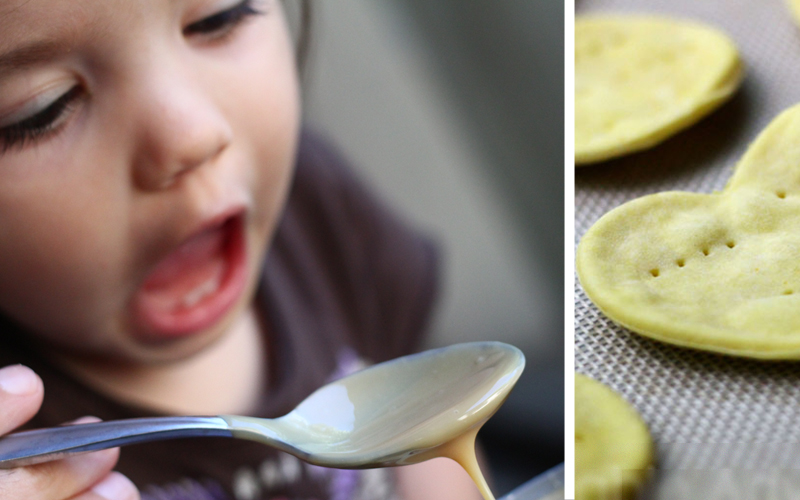
Get your taste buds ready – this week’s Chilean Global Table is going to be sweet. As in … full of sweets. I never had much of a sweet tooth… until I was pregnant with Ava. Then it was “give me ice cream” and “let me eat cake” nonstop for 9 months. Well, really 10 months, since I was two weeks late. Two weeks. Let’s just say I haven’t recovered. And neither has my swollen sweet tooth. Chicken Pastel del Choclo [Recipe] Shredded chicken tossed with onion, hardboiled egg, green olives, raisins, and spices. The entire mixture is then covered with smooth corn puree. Pan Amasado (Chilean Rolls) [Recipe] Rich, dense rolls made with yeast and lard. Chilean Alfajores [Recipe] Alfajores are popular throughout South America, but our version is typical to Chile. In Chile, Alfajores are soft, curled cookies- usually flavored with orange zest and/or liqueur. On their own they are doughy, rather than sweet – making the perfect base for an ooey gooey spoonful of sweet Dulce de Leche. Dulce de Leche [Recipe] Sweetened …
Read More

Chile is a slice of South America as skinny as an asparagus and, yet, bursting with temptations for our Global Table! First, there’s Chile’s undeniable love affair with fish, eels, and anything that flips or flops (or slithers) in the water, along their rambling shores. Linda Bladholm, author of Latin and Caribbean Grocery Stores Demystified, tells me they have the most incredible seafood. In an email to me she writes: I was in Patagonia, Santiago and the Atacama desert. The best strange thing I ate was the picoroco or large beaked barnacle. It looks like a volcano and when heated, two claws emerge from the crater on top. They taste like a cross between crab and lobster and are good in soup or baked. The Giant centolla crabs are like snow crabs on steroids. One leg makes a meal. For those who don’t have access to such exotic seafood, Chile provides countless dishes with beef and chicken, like empanadas. Another favorite is an unusual casserole containing meat, hardboiled egg, green olives, raisins, cumin and other spices, topped with …
Read More
Please note: Due to last week’s illness, this meal review covers both Central African Republic & Chad. I’m not sure if anyone’s keeping track, but I haven’t had the best luck with yucca. At this rate, we’ll never be friends. First, there was the Baton de Manioc fiasco- for our Angolan Global Table. That night, after eating several of the batons, I blacked out – lost hearing and sight – crashed to the floor and went into shock. The scariest part? I was holding Ava. Thankfully Keith caught her as she was slipping out of my arms – head first, I might add – and kept her from tumbling down onto the tile. I still get choked up thinking about what could have happened that night. The doctor blamed dehydration, but I’m pretty sure overindulgence in yucca had something to do with it. Second, there was the yucca based sweet, Getuk Lindri – for our Brunei Global Table. Even after doing hours of research I was unable to make a good batch of Getuk Lindri. …
Read More
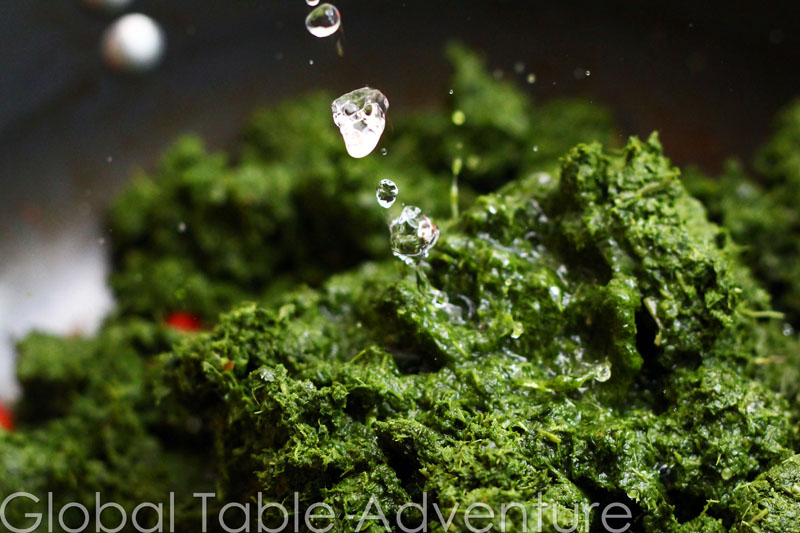
Serves 4-6 Cassava leaves are highly fibrous, dense and grassy. We found ours frozen and “ground” at Ebutte Tropical Market – which saved us a lot of sweat around a mortar and pestle. You could easily double the aromatics in this recipe as the flavors rather get lost behind the domineering cassava. Ingredients: red palm oil 1 large onion, chopped 2 tomatoes, chopped 1 1/2 lbs fresh ground cassava leaves 1 Tbsp peanut butter water salt pepper Method: Thaw out some fresh ground cassava leaves. Over medium heat, cook chopped onion in a drizzle of red palm oil. Note how the oil stains the onions gold. Add tomatoes. And the cassava leaves. The smell will transport you to hay-ville. If such a place exists. Add enough water to keep things moist and sludgey, so that the mixture doesn’t burn. Bring to a simmer. Stir in peanut butter. Stew over low heat, covered, for about 30 minutes. Serve immediately with an Adventurous spirit. Stewed Cassava Leaves Votes: 0 Rating: 0 You: Rate this recipe! Print Recipe …
Read More
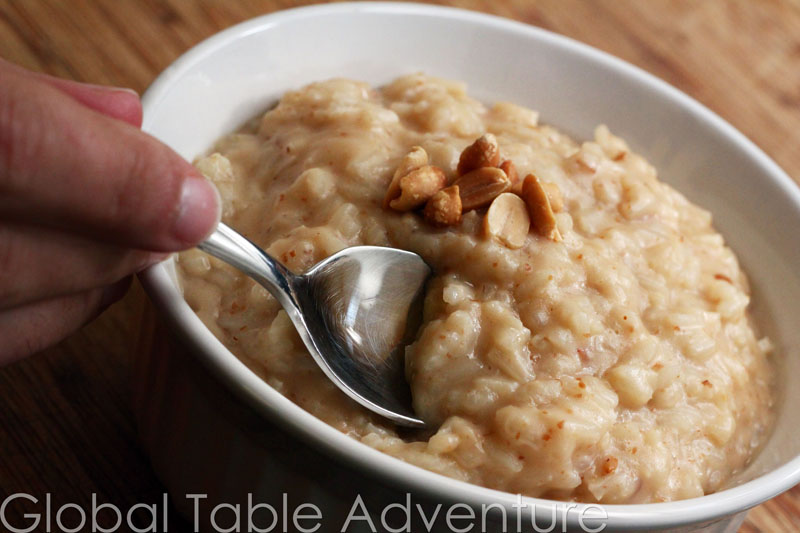
Serves 2-4 If you’re looking for a sweet treat, but the pantry is rather dry, this African peanut butter rice might do the trick. The dish reminds me of peanut butter rice pudding – thick, sweet, and comforting. Ingredients: 1/2 cup white rice 1 1/2 cups water 1/4 cup natural peanut butter 1/4 cup sugar 1/8 cup water additional water, as needed Method: Bring water to boil. Add rice and simmer, uncovered for 15 minutes 2. Meanwhile, mix together peanut butter, sugar, and 1/8 cup water. Natural peanut butter is best because then you can control how sweet your dessert is. I could eat this straight from the bowl. Mmm. When the rice is almost done cooking… … pour peanut butter mixture over rice and stir in. Continue simmering until rice is perfectly tender. Add water as necessary to keep the consistency loose, like rice pudding. Enjoy warm or cold, with a big sweet tooth. Sweet Peanut Butter Rice | Bouiller Votes: 0 Rating: 0 You: Rate this recipe! Print Recipe If you’re looking for …
Read More
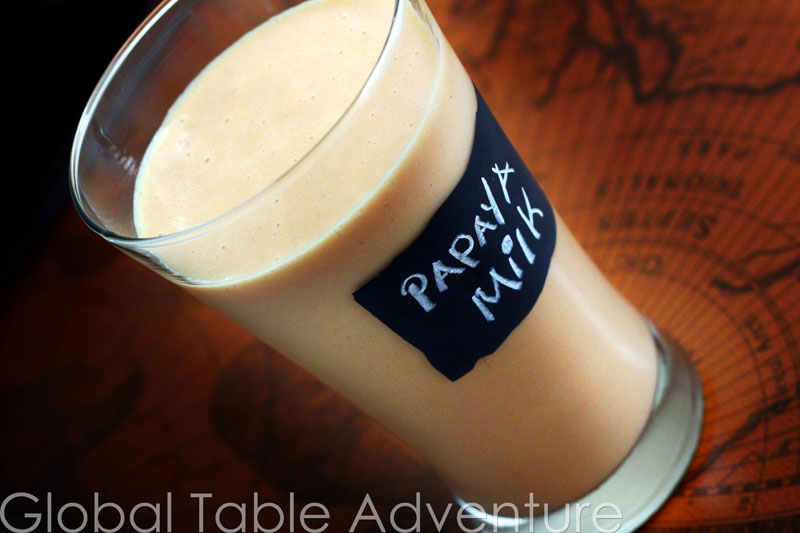
Serves 2 Thick, creamy, and spicy, this drink popular in Northern Chad is refreshing and healthy. Ingredients: 4 cups cubed papaya (if fresh is unavailable you can use 2 cans, drained) 2 cups milk 3 Tbsp sugar 1/4 tsp cardamom pinch ginger 1-2 cups ice, as desired Method: Gather your ingredients. First the beautiful papaya… drained and ready for the blender… Then the spices. Start off with just a little and add the full amount if you can handle it! 🙂 Dump into a blender with some cold milk… And ice, to taste. You can make this drink as thick or as thin as you like. Make it on a wickedly hot day, or a balmy night. Or right this minute. Spiced Papaya Milk Votes: 0 Rating: 0 You: Rate this recipe! Print Recipe Thick, creamy, and spicy, this drink popular in Northern Chad is refreshing and healthy. CourseDrinks, Sweets Lifestyle5-ingredients or less, Vegetarian Food TypeCold Drinks, Fruit, Non-Alcoholic Drinks Servings 2 people Servings 2 people Spiced Papaya Milk Votes: 0 Rating: 0 You: Rate …
Read More
Makes about 2 cups Raw seeds give Egusi sauce grassy flavor and a little bit of texture. The sauce is popular in central Africa, and can be served over vegetables, meats, and fish. Ingredients: 1 small onion 1 tomato 1 chili pepper (I used a poblano from my garden, but you can go as spicy as you want with this recipe) salt red chili powder, to taste 1 1/2 cups ground egusi 1/2 cup water (or as needed) Method: Hunt down some ground melon seeds. I found these at our local African market. Latino stores have pepitas, or pumpkin seeds, which are an acceptable substitute. In a food processor, add tomato… Coarsely chopped onion … And a chili pepper. I left the poblano on the plant long enough that it turned red. The extra time on the plant made it sweeter 🙂 Puree everything together… Add it to a small pot with the egusi… Some salt and pepper… And water… Things don’t look so tasty here… but as the water mixes in, things smooth out. …
Read More
Happy Saturday! Nothing like starting your day off with a little grubworm stew… And here are some images of Central African Republic’s land…
Read More
Hope you have a lovely day! A day in the life of a street corner in Chad: A tourist video (in French): Cooking For Dad’s Images of Chad:
Read More
I bought an apron this summer. It was time to face facts. I’m 31 years old, I’m a mess in the kitchen, and I’m not getting any cleaner. Flour is probably my only regular fashion accessory (although I do love necklaces). In addition, flour is almost always my only chance at “makeup.” As I twirl through the kitchen, I regularly dust flour on my nose, through my hair, and – yes – even on poor little Ava. She’s really a good sport though – she hardly ever notices. So, in honor of flour’s persistent role in my life, let’s talk … flour. This photo shows millet and all-purpose, wheat flour. Around the world, people use all sorts of flour in their food, depending on access to native plants, special diets, and basic needs. In Africa, the most common are flours are Millet, Cassava, Tapioca, Teff, and wheat. In day to day life, flour is typically used to make one of the following items: porridge thick and starchy fufu dumplings fried beignets/doughnuts About flour in this …
Read More
Serves 2-3 Amazingly enough, Keith had never had lamb before we embarked on our Adventure to eat food from around the world. This stew is so fresh and flavorful it won him over immediately. Serve with millet balls. The key to making good lamb stew is to simmer -never boil – the meat. For the first hour the meat will seem tough and chewy but, incredibly, in the second hour even the toughest cut softens, tenderizes and gets that “melt in your mouth” quality that makes stew completely irresistible. Ingredients: vegetable oil 1 1/2 lb lamb, cubed 1 large onion, chopped 1 bell pepper, cut into strips 1 tsp paprika 1 Tbsp tomato paste 4 cups water, or as needed 1/2 lb chopped okra Method: Heat a little oil in a medium pot. Brown lamb – do not crowd. Brown in small batches if needed. When done, return all the meat to the pot and crank the heat to get things moving. Add onion, bell pepper, paprika and tomato paste. I emptied out my paprika jar …
Read More

